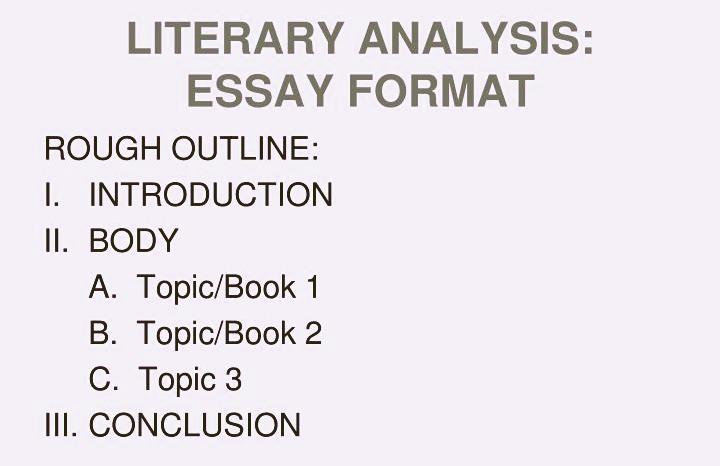
How to Compose a Good Literary Analysis Essay Outline
Typically, a literary analysis essay outline should incorporate the following constituent parts:
- Introduction. It is important to learn how to make an introductory part effective.
- The body. This section should contain the main statements and the supporting evidence.
- Conclusion. The main function of this part is to restate the thesis and summarize the presented ideas.
Learning how to write a literary analysis, it is recommendable to search for the samples online and try to follow them in your own writing. However, keep in your mind that the outline should be composed accurately, with considerable attention paid to every feature of the literary work under analysis.
Typically, each essay devoted to literary analysis comprises a well-written introduction, efficient body, and a smart conclusion.
Introduction. All the guidelines about how to write an analysis paper emphasize that the first paragraph of the essay should be the introductory part. You definitely want to grasp the readers’ attention from the first lines, so the introduction should be creative. If it catches your audience’s attention, it is written in a proper way. Try to learn more to become a talented writer.
Body. When you wonder how to do a literary analysis properly, you mostly think about writing the main part of the text. It is logical because the paragraphs of the body contain your main thoughts about the poem, novel, short story, or any other literary piece under analysis, as well as the statements, explanations, and evidence used for supporting the ideas.
Conclusion. The essay structure outline refers to the concluding part as the last but very important section of the essay. Here, the writer shows the connection between the literary analysis and the analyzed book, the way it demonstrates the plot and the author’s ideas.
Literary Analysis Outline: How to Structure It Properly
Here is a sample literary analysis outline for a great essay which can earn you respect and interest of your readers.
Title
Paragraph 1: Introductory part paragraph outlines
- A catching hook
- Name of the author
- Title of the literary piece
- Main characters
- Brief summary
- Thesis
Paragraph 2: Body Paragraph 1
- Topic sentence (the main topics discussed in the paragraph according to the analysis essay format and their relation to the thesis)
- Quote context: The author of the quote / What events can be traced in the text when the quote is used?
- Quote cited in the proper way
- Quote analysis: does it support your thesis? Which way?
- Closing sentence with a smooth transition to the following body paragraph.
Paragraph 3: Body Paragraph 2
- Topic sentence (the main topics discussed in the paragraph and their relation to the thesis)
- Quote context: The author of the quote / What events can be traced in the text when the quote is used?
- Quote cited properly
- Quote analysis: does it support your thesis? Which way?
- Closing sentence with a smooth transition to the following body paragraph.
Paragraph 4: Body Paragraph 3
- Topic sentence (the main topics discussed in the paragraph of the critical essay and their relation to the thesis)
- Quote context: The author of the quote / What events can be traced in the text when the quote is used?
- Quote cited properly
- Quote analysis: does it support your thesis? Which way?
- Closing sentence with a smooth transition to the following body paragraph of a process analysis essay.
Conclusion
If you know how to start a literary analysis, you should also conclude it effectively (the order of the following parts is optional)
- Summarization of the argument.
- Extended argument.
- Demonstration of the importance the text has.
When you analyze paper, you think about the following question: what is an essay outline? Why should I use it? Have a look at the following advice on how to write an introduction, how to work on the body, and how to write a conclusion for a literary analysis.
Effective Paragraph Outlines
Great paragraph outlines have the following typical look:
- Title
- Opening paragraph of the introduction with the included
a. hook, name of the author, title of the literary work, presentation of the main characters, concise summary, and thesis;
b. hook: The first sentences draw the reader’s interest with an outstanding fact, a wise quote, a bright description, a metaphor, or an analogy.
c. writing a literary analysis, you should use the introduction to identify the literary work, its author, and the main ideas in a nice thesis.
- Body: logical support of your thesis.
a. The focus of every paragraph is on a single idea which is connected to the thesis.
b. The paragraphs should comprise:
Topic sentence to state the main idea of the paragraph in the form of a mini-thesis or a headline. It should both ensure the connection between the body and the main thesis and give a definition of the paragraph.
Quote context: Who says the quote and when? / Introduction of the speaker in a particular situation.
Quote - a particular example applied as evidence for the support of the thesis.
Commentary - interpretation of a particular detail.
Concluding Sentence that connects the details and supportive commentary with the thesis statement.
- Conclusion: the paragraph that convinces the reader in the significance of the arguments and concludes the text.
a. Argument summary AND extension of the argument.
b. A good conclusion restates the thesis and gives a summary of the essay.
What is the Purpose of a Literary Analysis Essay?
When you ask yourself, “What is the purpose of a literary analysis essay?” you definitely know that your opinion makes a difference and is important. You demonstrate that you understand a certain literary phenomenon and can help the readers get an insight into the main ideas. Effectively used examples and good logic play a significant role in the quality of the essay.

